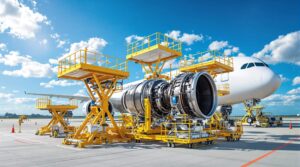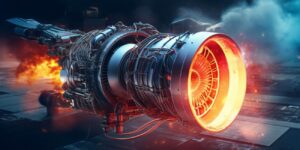One of the noteworthy alternatives is biofuels, derived from organic sources such as crops or algae. These fuels offer a potential reduction in carbon emissions compared to conventional jet fuels. With the ability to be produced from renewable resources, biofuels are considered a promising solution for mitigating the environmental impact of air travel. However, challenges related to scalability and competition with food production need to be addressed for widespread adoption.
Another contender in the quest to substitute aircraft fuel is hydrogen. Hydrogen-powered aircraft have gained attention due to their potential to produce zero-emission flights. The combustion of hydrogen releases only water vapor, making it a clean energy source. However, the development of hydrogen infrastructure and the need for advanced storage technologies pose significant challenges to its widespread use in aviation.
Electric propulsion is also emerging as a potential solution for aircraft fuel substitution. Electric aircraft, powered by batteries or hybrid systems, aim to reduce emissions and dependence on traditional fuels. The advantages include lower operating costs and decreased environmental impact, but current technological limitations, such as battery weight and energy density, hinder the widespread adoption of electric propulsion in commercial aviation.
While exploring alternatives, it’s crucial to consider synthetic fuels. These fuels are produced through chemical processes, often utilizing carbon captured from the atmosphere. Synthetic fuels can be designed to closely resemble traditional jet fuels, making them compatible with existing aircraft and infrastructure. However, the production costs and energy requirements for synthetic fuels remain challenges that need to be addressed for widespread commercial use.
Additionally, a lesser-explored alternative is the use of liquefied natural gas (LNG) in aviation. LNG has lower carbon emissions compared to traditional jet fuels, and its infrastructure is already established in other industries. However, the challenges lie in the energy-intensive liquefaction process and the need for adapted aircraft engines to utilize LNG efficiently.
Finding the most efficient and cost-effective aircraft fuel alternatives including biofuels, synthetic fuels and hydrogen
Efforts to find the most efficient and cost-effective aircraft fuel alternatives are gaining momentum as the aviation industry seeks to reduce its environmental impact. The quest for sustainable aviation fuels encompasses a range of options, including biofuels, synthetic fuels, and hydrogen, each presenting unique opportunities and challenges.
Biofuels have emerged as a promising avenue for reducing carbon emissions in aviation. Derived from biomass sources such as plants and algae, biofuels offer a more environmentally friendly alternative to traditional jet fuels. They can be categorized into first-generation and second-generation biofuels. First-generation biofuels are derived from food crops, while second-generation biofuels use non-food feedstocks, mitigating concerns about competition with food production.
The advantages of biofuels lie in their compatibility with existing aircraft engines and infrastructure. They can be blended with conventional jet fuel in various ratios, providing a gradual transition towards more sustainable aviation. However, challenges include the competition for land between food and biofuel crops, as well as the cost of production compared to conventional fuels.
Synthetic fuels, also known as e-fuels or electrofuels, are generated through the electrolysis of water to produce hydrogen, which is then combined with carbon dioxide captured from the atmosphere or industrial processes. The resulting synthetic hydrocarbons can be used as drop-in replacements for traditional jet fuels. Synthetic fuels offer the potential to decarbonize aviation without requiring significant changes to existing aircraft or infrastructure.
The key advantages of synthetic fuels include their potential for carbon neutrality when produced using renewable energy sources. Additionally, they can leverage existing distribution networks, easing the transition for the aviation industry. However, challenges include the high energy input required for production and the need for substantial scale-up to make them economically viable.
Hydrogen has garnered attention as a clean energy carrier with the potential to revolutionize aviation. In the context of aircraft, hydrogen can be used directly in fuel cells or through combustion in modified gas turbine engines. Hydrogen’s main advantage lies in its zero-emission combustion, producing only water vapor as a byproduct.
However, the use of hydrogen in aviation faces technical challenges, including the need for innovative storage and distribution solutions due to its low energy density. Aircraft would require significant modifications to accommodate hydrogen storage and fuel systems. Furthermore, the production of hydrogen, especially through green electrolysis, demands substantial investments in renewable energy infrastructure.
Assessing the feasibility and accessibility of substitutes such as biofuels and synthetic fuels
Assessing the feasibility and accessibility of substitutes for traditional fuels, such as biofuels and synthetic fuels, requires a comprehensive evaluation that considers various analysis options. These alternatives have gained attention due to their potential to address environmental concerns and reduce dependency on finite resources.
The pros of biofuels lie in their renewable nature, as they are derived from organic materials such as crops, algae, or waste. Their production emits fewer greenhouse gases compared to conventional fuels, contributing to a more sustainable energy mix. Additionally, biofuels can be used in existing combustion engines with minimal modifications, providing a smoother transition in the transportation sector.
On the other hand, synthetic fuels present a different set of advantages. Their production can be tailored to meet specific energy needs, and they offer a potential solution for sectors that are challenging to electrify directly, such as aviation and heavy-duty transportation. The versatility of synthetic fuels makes them a promising candidate for a diversified energy portfolio.
However, a thorough analysis reveals certain cons and limitations associated with these substitutes. One major concern is the competition for land and resources in biofuel production, which may lead to deforestation and impact food supply chains. Moreover, the energy-intensive processes involved in producing synthetic fuels raise questions about their overall environmental footprint and long-term sustainability.
Considering the constraints of these alternatives, it’s essential to address technological challenges and economic viability. Both biofuels and synthetic fuels require substantial investment in research and development to improve efficiency and reduce production costs. Additionally, the existing infrastructure for traditional fuels poses a constraint on the widespread adoption of these substitutes, requiring significant changes to accommodate their integration into current energy systems.
In the options available for transitioning to alternative fuels, policymakers and industry stakeholders must weigh the pros and cons while acknowledging the limitations and constraints inherent in each choice. A balanced and nuanced evaluation is crucial to ensuring a sustainable and effective shift towards cleaner and more accessible energy sources.
Examining the modifications required to enable aircraft to use fuels like hydrogen and synthetic kerosene
To propel aviation into a more sustainable future, extensive modifications are imperative for aircraft to embrace alternative fuels like hydrogen and synthetic kerosene. These upgrades go beyond mere tweaks, demanding comprehensive retrofits and intricate adjustments throughout the aircraft’s systems.
Firstly, the transition to hydrogen as a primary fuel source necessitates substantial alterations in the aircraft’s propulsion system. Traditional jet engines, designed for conventional fuels, must undergo modifications to accommodate the unique combustion characteristics of hydrogen. This involves refining combustion chambers, adjusting fuel injection systems, and fortifying materials to withstand the challenges posed by hydrogen’s distinct properties.
Furthermore, the integration of synthetic kerosene involves intricate retrofits to the fuel delivery and storage systems. The chemical composition and combustion attributes of synthetic kerosene differ from traditional jet fuels, prompting the need for adjustments in fuel pumps, pipelines, and storage tanks. Ensuring compatibility without compromising safety or efficiency is a delicate task that requires meticulous modifications.
The aerodynamics of aircraft also demand alterations to optimize performance with alternative fuels. Hydrogen, being lighter than conventional jet fuel, may affect the aircraft’s weight distribution and balance. Consequently, modifications to the airframe design, including the placement of fuel tanks, may be required to maintain stability and safety during flight.
On the other hand, synthetic kerosene introduces unique challenges related to combustion characteristics. The combustion efficiency of synthetic fuels may differ, necessitating adjustments to engine control systems to optimize performance. These retrofits extend to the aircraft’s avionics, ensuring seamless integration with the modified propulsion systems.
The transition to sustainable aviation fuels also demands upgrades in infrastructure. Airports and refueling facilities need significant modifications to handle the storage, transport, and distribution of alternative fuels. This involves retrofitting existing facilities and constructing new infrastructure to meet the specific requirements of hydrogen and synthetic kerosene.






